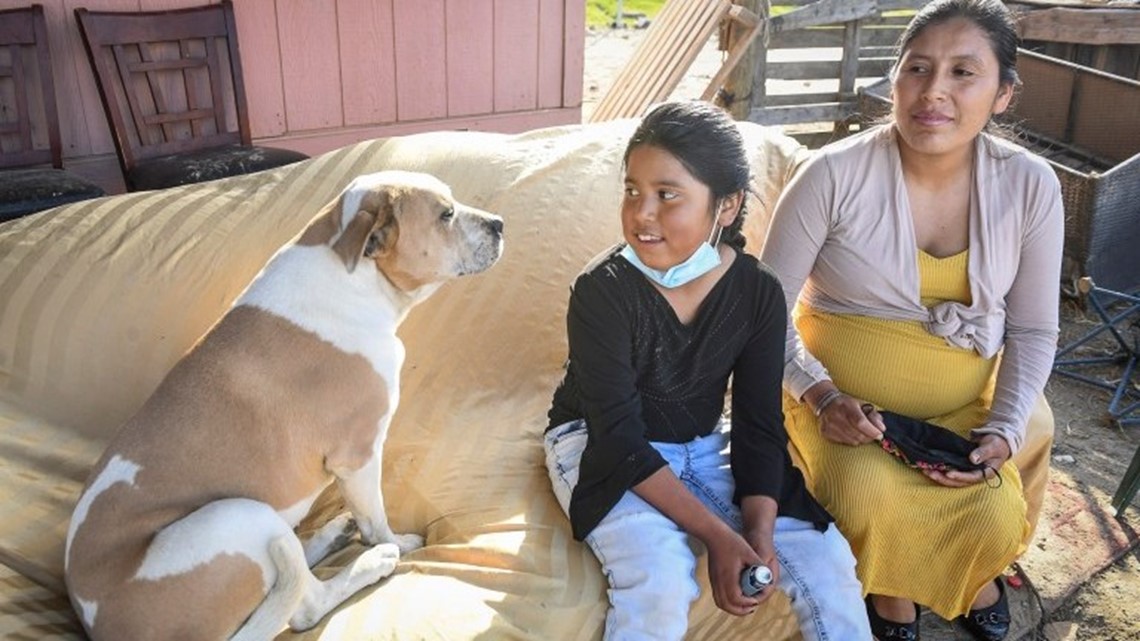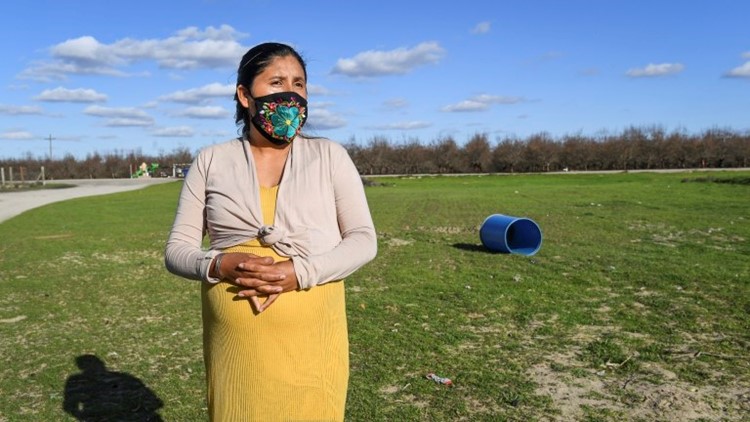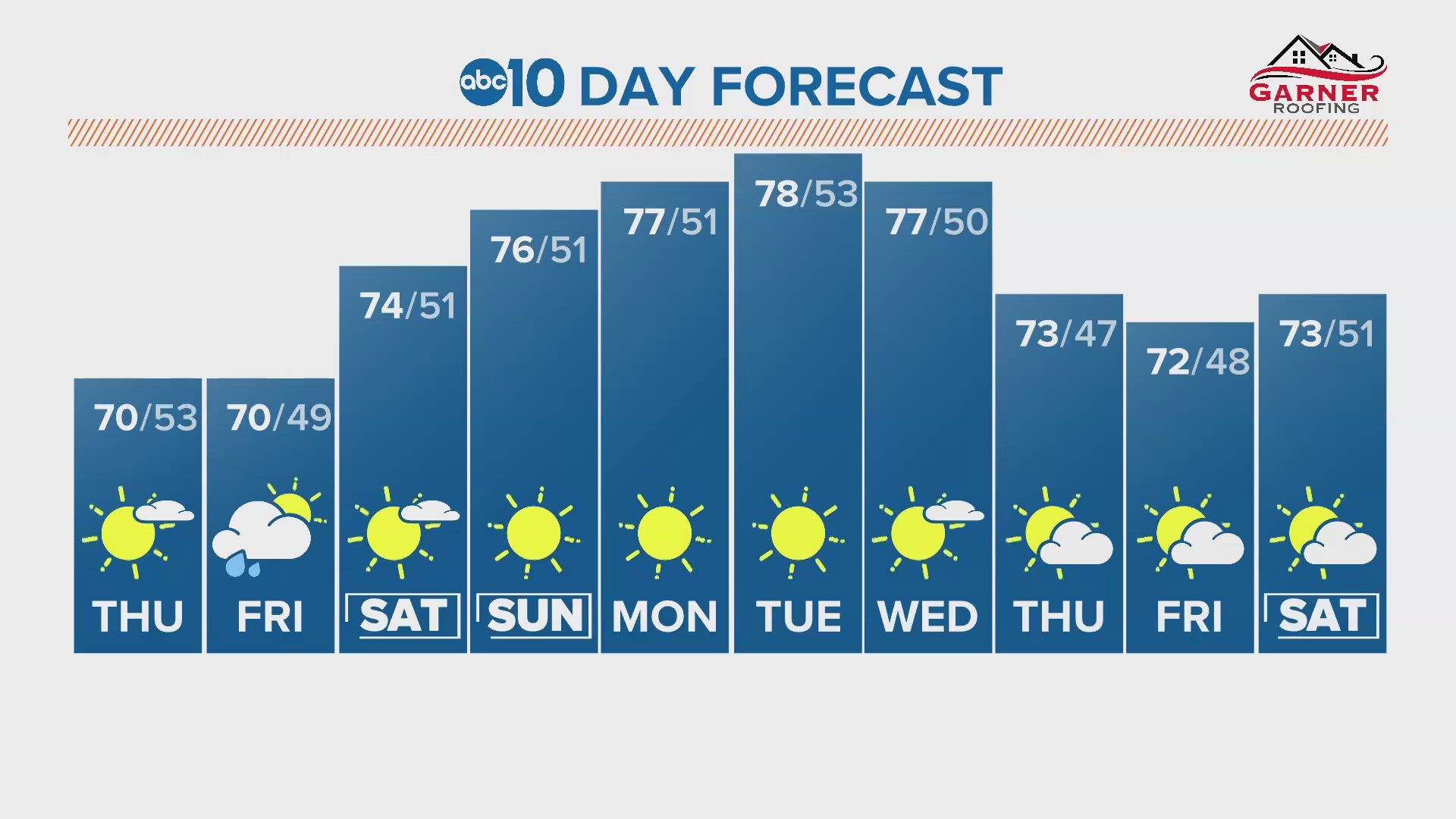CALIFORNIA, USA — Laura García is haunted by the last time her daughter woke her up in the middle of the night, struggling to breathe.
It was 2019, during the rainy season, when growers burn piles of grapevines surrounding her home in Raisin City, near Fresno. That day, García recalls smelling smoke. And that night, her daughter Kenia García was fighting so hard to breathe that she couldn’t speak.
Her father rushed her to the hospital, where doctors tried to soothe her struggling airways and lungs. Her father stayed with her there, missing work in the vineyards, while García stayed home with their four other children, spending sleepless nights thinking about her daughter.
On video chats, Kenia pleaded with her mother to come to the hospital and be by her side. “I didn’t cry in front of her with the camera on, because she would become more sad,” she said in Spanish. “I had to show her a strong mom, to give strength to my girl.”
Throughout the San Joaquin Valley, growers burn thousands of tons of waste in vineyards and orchards a year, sending up plumes of particles and gases that are known to exacerbate asthma and cause other serious health problems.
Now, the California Air Resources Board is poised this week to decide whether to stop the burning that stretches across eight counties, from Lodi to Lebec.
Under the proposal, the board would direct its staff to work with the San Joaquin Valley’s air district to ban virtually all agricultural burning by the end of 2024.
San Joaquin Valley vineyards and orchards would have to haul vines, trees and other waste that they are still burning to composting or biomass plants, or grind it up in chipping machines. From $15 million to $30 million a year in federal, state and local funds would be needed to help growers cover the costs, according to an air board report.
Environmental justice advocates are watching the upcoming decision closely as a signal of the air board’s priorities under its new leadership. Air board chair Mary Nichols, who retired from her post at the end of December, came under fire from activists who said she failed to protect low-income communities of color that are disproportionately harmed by air pollution.
“The conversation and the decision that they make there will definitely help set the tone for what’s going to happen over the next few years,” said Catherine Garoupa White, executive director of the Central Valley Air Quality Coalition. “I hope that under new leadership, they show more courage.”
A state law enacted in 2003 was supposed to end burning in the region by 2010.
Estela Escoto, who lives in Arvin and has severe allergies worsened by smoke, said four more years is too long to wait.
“It makes you feel anger, a lot of powerlessness because you’re not able to do things faster… to make these people understand that pollution is hurting human beings,” she said in Spanish.
Missed deadline
Statewide, burning agricultural material spewed about six tons of fine particles per day on average in 2017— equivalent to about 12 million cars, according to the Air Resources Board.
More than a third of that pollution occurs in the San Joaquin Valley, which suffers some of the nation’s unhealthiest air quality.
Burning is the easiest way to dispose of agricultural waste, clear patches of land for new planting and beat back weeds, pests and disease. When a tree falls in an orchard, stubble is left on rice fields or prunings and vines have piled up, the simplest and cheapest solution is usually burning.
In much of California, on days when the air is clear and weather conditions are less likely to let smoke linger, growers with permits from their local air districts can burn their prunings and other waste.
But it’s different in the San Joaquin Valley, where a 2003 state law authored by then-Sen. Dean Florez, a Democrat from Shafter, aimed to phase out burning by 2010.
The San Joaquin Valley Air Pollution Control District has already banned burning a wide range of crops, including field crops like wheat, most rice stubble and prunings from some fruit trees. But other material — including vineyards and some orchard material — is still burned because of loopholes in the law.
More than 10 years later, the valley hasn’t yet met its deadline to ban burning.
“It has to end,” said Florez, who is a member of the air board. “It was the dark ages in 2003. And we’re still in the dark ages in 2021, which is even more disheartening.”
Why doesn’t the state board just ban all burning? It’s because regulating it comes under a complex mishmash of local and state control. Agricultural burning typically falls under air district control, largely preventing the air board from acting unless lawmakers have authorized it to, as they did in the San Joaquin Valley more than 17 years ago.
The state already has granted the valley multiple extensions of the law’s deadline to ban burning. Now, on Thursday, the air board will consider a six-month extension to allow some burning and seek a near-complete ban by the end of 2024 from the local air district. Only diseased plants and beehives, as well as some weeds would be exempted.
If the board approves the proposal, its staff will force the local district to act by refusing to grant any more extensions, according to Michael Benjamin, the air board’s chief of air quality planning and science. “There will be no more concurrences after January 1, 2025,” he said.
Florez said the effort in the San Joaquin Valley could become a model for the rest of the state where burning is still bothering residents. But he acknowledges that growers will need financial help.
“The only thing that will not make this work is if the governor turns away from the funding,” Florez said. “He could be the only governor in California history to end an agrarian feudal practice that goes back hundreds of years, so people don’t go out and light up their trash.”
Growers say that without financial assistance, smaller operations could struggle to pay for pricier alternatives, such as chipping trees, vines and prunings and mixing them back into the earth.
“The cost is prohibitive. And we’re the only farmers in this state — in this valley — that have to do all these things,” said Manuel Cunha, president of a grower organization called the Nisei Farmers League. “So it puts my growers at a totally economic disadvantage. And yet our farmers want to do things right. And want to be safe.”
Dwayne Cardoza, an organic raisin grape grower in Easton, California, and interim chairman of the Raisin Bargaining Association, expects regulations to put an end to the practice sooner rather than later.
“We see the handwriting on the wall.”
Burning has increased three-fold
Between 2011 and 2014, agricultural burning in the San Joaquin Valley had plummeted by 80% from the roughly one million tons that had been burned every year before 2004.
But since that period, yearly burning increased three-fold, reaching 600,000 tons of agricultural waste last year.
The increases were driven in part by drought, which forced growers to rip out thirsty orchards and vineyards, district officials say. Biomass facilities that burned prunings, trees, and vines to produce power also closed, leaving fewer options for agricultural waste.
Vineyards were responsible for nearly three-quarters of the waste burned last year in the valley.
“The crop categories that are remaining are the trickiest,” said Brian Clements, director of permit services with the San Joaquin Valley air district. “We’ve made a lot of progress in banning burning in many other categories. We continue to make progress. We’ve characterized it as a lot has been done.”
The uptick worries state officials as they struggle to bring the valley into compliance with federal standards for dangerous fine particle pollution.
Because of the surge in burning, “we’re much more concerned about it,” said the air board’s Benjamin. “And we do still hear complaints from community groups about smoke from agricultural burning in the valley.”
Nayamin Martinez, executive director of the Central California Environmental Justice Network, said that after 18 years, the valley should be ready to end agricultural burning.
“You don’t need more time, I’m sorry,” Martinez said. “That’s an insult.”
Alternatives to burning
The San Joaquin Valley air district has set aside about $25 million to encourage growers to use alternatives to burning. About $18 million has gone to grants that aim to keep about 900,000 tons of material from being burned, air district spokesperson Jaime Holt told CalMatters.
A phaseout of burning over the next four years would cost about $50 million to $60 million per year, so growers need state help, district officials said. “We need them to follow through on their efforts and support for finding dollars for this program,” Clements said.
One alternative to burning is to chip trees, prunings and vines, and mix the chippings back into the soil. Recycling entire almond orchards this way would increase organic matter and make the soil better at retaining water, according to research funded by the state and the Almond Board of California.
“That’s going to be a game changer, I tell you,” said Christine Gemperle, an almond grower with orchards in Merced and Stanislaus counties.
Gemperle recycled a 20-acre orchard at the end of her trees’ productive 25-year life, and said the trees are growing so beautifully her neighbors have noticed. She now has plans to recycle a 92-acre orchard.
But chipping is pricey, especially for smaller operations that can’t distribute the costs across hundreds of acres. And even Gemperle burns trees that topple unexpectedly.
Gemperle estimates it costs about $290 an hour to pay a contractor to chip prunings, so she and her brother prune their trees only every other year to cut costs. As for chipping an entire orchard and reincorporating it into the soil, Gemperle said she’s seen quotes for between $1,200 and $2,200 to bring in the equipment, plus up to $700 per acre for the work.
She hopes the state subsidizes a mobile chipping program that can tackle toppled trees and take care of smaller growers’ waste.
“I’d love to see no burning. But at this point, it’s a tool that some people need, because that’s all they’ve got,” Gemperle said. “And if you take that away, then what are they gonna do?”
Vineyards are especially challenging because non-burn strategies require extracting wire trellises embedded in the vines.
“It’s quite a bit more expensive because you’ve got to take all the wire out, you’ve got to take all the stakes out, you’ve got to take all the drip hoses out,” said Cardoza, the organic grape grower.
Still, he does it anyway — at around double the cost, he said. He also shreds raisin trays and reincorporates the shredded material back into the ground rather than burning it. “We’re very concerned about environmental situations and what we’re doing to mitigate some of that,” Cardoza said.
One advantage to chipping over burning is that growers don’t need to wait for the right weather conditions, said Eric Marthedal, a fourth-generation farmer in the Fresno area who grows grapes, blueberries and almonds and runs a side business chipping vineyards.
Still, Marthedal sees a need to keep some burning in the valley’s toolbox.
“Yes, they’re coming out with more and more alternatives, but ag burning, I feel like, still has its place,” Marthedal said. “Whether it’s for disease, or for location, or price — for now, all of those things, it does still have its place.”
Stay or leave
Regardless of the state’s decision, Tom Frantz, 71, is leaving the San Joaquin Valley. A retired math teacher and clean-air advocate, he grows almonds on a 36-acre patch of Kern County. He is the fourth generation of his family to live and farm there.
He said he’s too old to wait for clean air.
“To allow even more pollution when it’s not absolutely necessary — to allow it for economic reasons, I mean, actually, it makes me mad,” said Frantz, who has a heart condition that air pollution can worsen. “And I can’t afford to get mad anymore, because of my heart problems.”
After decades of participating in lawsuits against local, state and federal governments to clean up the San Joaquin Valley’s air, Frantz bought a home on the coast and has been driving his electric car there to breathe the cleaner air.
“I’m very sad that I can’t die here, where my father and grandfather and even great grandfather died,” he said. “But in the end, what I’m happy about is there’s a younger generation very concerned about air quality in the San Joaquin Valley, and they are getting involved.”
Laura García, a 32-year-old mother of five, told the San Joaquin Valley air district board at a December meeting that smoke lingers in her neighborhood, where children with asthma and pregnant women live.
“I feel that they worry more about the money of the ranchers than the health of the community,” she said in Spanish.


At home in Raisin City, García always keeps her daughter Kenia’s inhalers at hand, and doesn’t let her outside when there’s smoke in the air. Though she had been hospitalized for asthma attacks before, she hasn’t been hospitalized since those harrowing days in 2019. No one knows for certain whether the smoke caused her hospitalization, but experts say exposure can lead to severe attacks in vulnerable people.
García is now six months pregnant, and dealing with breathing problems of her own by wearing an N95 mask whenever the air quality is poor — both outside and inside of her house.
“I’m worried because I already have one daughter with asthma and I don’t want another,” she said in Spanish.
But García said she’s staying put to fight for changes to agricultural burning. “If you don’t begin to fight, who will?”
Jackie Botts contributed to this report.
CALmatters.org is a nonprofit, nonpartisan media venture explaining California policies and politics.



